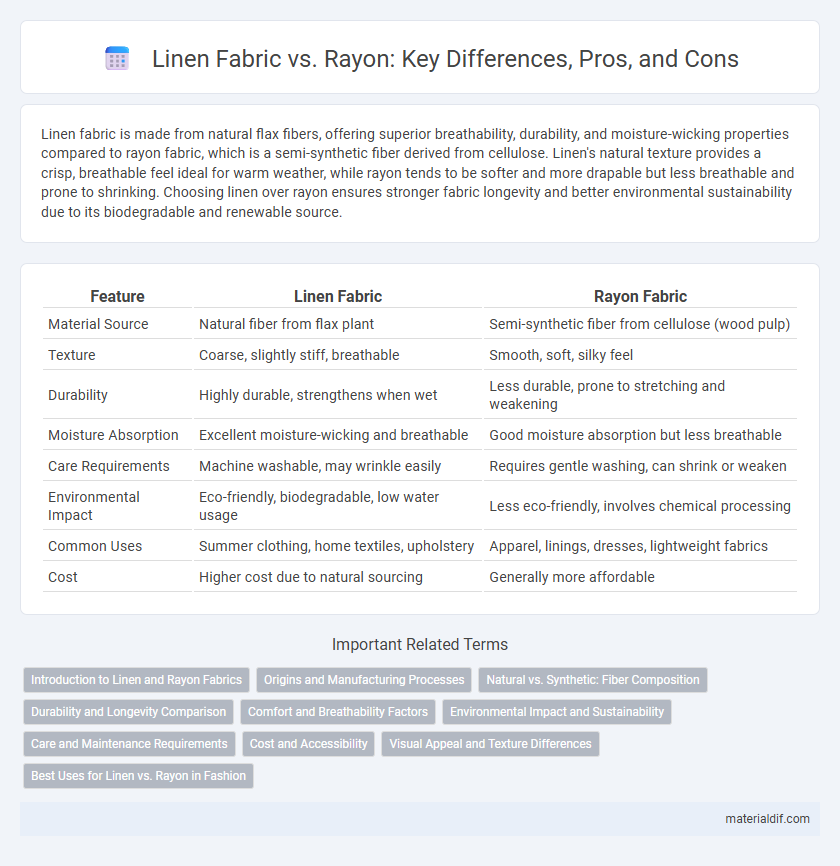Linen fabric is made from natural flax fibers, offering superior breathability, durability, and moisture-wicking properties compared to rayon fabric, which is a semi-synthetic fiber derived from cellulose. Linen's natural texture provides a crisp, breathable feel ideal for warm weather, while rayon tends to be softer and more drapable but less breathable and prone to shrinking. Choosing linen over rayon ensures stronger fabric longevity and better environmental sustainability due to its biodegradable and renewable source.
Table of Comparison
| Feature | Linen Fabric | Rayon Fabric |
|---|---|---|
| Material Source | Natural fiber from flax plant | Semi-synthetic fiber from cellulose (wood pulp) |
| Texture | Coarse, slightly stiff, breathable | Smooth, soft, silky feel |
| Durability | Highly durable, strengthens when wet | Less durable, prone to stretching and weakening |
| Moisture Absorption | Excellent moisture-wicking and breathable | Good moisture absorption but less breathable |
| Care Requirements | Machine washable, may wrinkle easily | Requires gentle washing, can shrink or weaken |
| Environmental Impact | Eco-friendly, biodegradable, low water usage | Less eco-friendly, involves chemical processing |
| Common Uses | Summer clothing, home textiles, upholstery | Apparel, linings, dresses, lightweight fabrics |
| Cost | Higher cost due to natural sourcing | Generally more affordable |
Introduction to Linen and Rayon Fabrics
Linen fabric, derived from the flax plant, offers exceptional breathability, moisture-wicking properties, and durability, making it ideal for warm climates and eco-conscious consumers. Rayon fabric, a semi-synthetic textile made from cellulose fibers, mimics the softness and drape of natural fibers while providing versatility in texture and color. Both fabrics serve diverse fashion and home textile needs, with linen emphasizing natural fibers and sustainability and rayon highlighting affordability and a smooth finish.
Origins and Manufacturing Processes
Linen fabric originates from the flax plant, processed through natural retting, drying, and weaving, emphasizing eco-friendly and traditional methods. Rayon fabric is semi-synthetic, derived from cellulose in wood pulp treated chemically to produce versatile textile fibers. The manufacturing of linen involves mechanical and natural treatments maintaining fibers' strength, while rayon requires chemical solvents and regeneration processes to create soft, absorbent material.
Natural vs. Synthetic: Fiber Composition
Linen fabric is made from natural flax fibers, known for their strength, breathability, and moisture-wicking properties, making it an eco-friendly choice. Rayon fabric, derived from regenerated cellulose fibers typically sourced from wood pulp, combines natural origins with chemical processing, classifying it as a semi-synthetic fiber. The fiber composition fundamentally affects durability, texture, care requirements, and environmental impact, with linen offering superior biodegradability and sustainability compared to rayon's synthetic additives.
Durability and Longevity Comparison
Linen fabric, made from flax fibers, boasts superior durability and longevity compared to rayon, which is a semi-synthetic fiber derived from cellulose. Linen's natural fiber structure provides exceptional strength and resilience, enabling it to withstand frequent washing and wear without significant degradation. Rayon, while soft and versatile, tends to weaken and lose integrity faster due to its semi-synthetic composition and lower resistance to abrasion and moisture.
Comfort and Breathability Factors
Linen fabric offers superior breathability and moisture-wicking properties compared to rayon, making it ideal for hot and humid climates. Its natural fibers allow better air circulation and a cooling effect on the skin, enhancing overall comfort during wear. Rayon, while soft and smooth, tends to retain heat and moisture, which can reduce comfort in warm conditions.
Environmental Impact and Sustainability
Linen fabric, derived from flax plants, is highly sustainable due to its low water usage, biodegradable nature, and minimal pesticide requirements compared to rayon, which originates from chemically-intensive wood pulp processing. The production of linen results in significantly lower carbon emissions and less chemical pollution, making it an eco-friendlier choice for environmentally conscious consumers. Linen's natural durability and biodegradability contribute to a reduced environmental footprint throughout its lifecycle, whereas rayon's manufacturing process often involves toxic solvents that harm ecosystems.
Care and Maintenance Requirements
Linen fabric requires gentle washing in cold water and air drying to maintain its natural fibers and prevent shrinking, while rayon fabric demands even more delicate care, often hand washing or dry cleaning, due to its susceptibility to water damage and stretching. Both fabrics benefit from ironing on low heat to avoid damaging the surface, but rayon is more prone to wrinkling and losing its shape compared to linen. Proper storage in a cool, dry place is essential for both materials to extend their lifespan and preserve texture.
Cost and Accessibility
Linen fabric generally carries a higher price tag than rayon due to its natural flax fiber origin and labor-intensive production, making it less accessible for budget-conscious consumers. Rayon, a semi-synthetic material derived from cellulose, offers a more affordable and widely available alternative that mimics some properties of natural fibers. The cost-effectiveness and easier accessibility of rayon fabric often position it as a popular choice for mass-produced clothing and home textiles compared to linen.
Visual Appeal and Texture Differences
Linen fabric boasts a natural, slightly coarse texture with visible slubs, lending a casual yet elegant visual appeal that enhances its breathability and durability. Rayon fabric offers a smooth, silky texture with a consistent sheen, providing a more polished and luxurious appearance but less structural rigidity compared to linen. The distinct tactile qualities of linen emphasize its organic charm, while rayon's sleek finish suits garments requiring a soft drape and vibrant color retention.
Best Uses for Linen vs. Rayon in Fashion
Linen fabric is ideal for breathable, durable summer clothing such as shirts, dresses, and suits due to its natural moisture-wicking properties and crisp texture. Rayon fabric, with its smooth, silky feel and excellent drape, works best for flowy garments like blouses, skirts, and eveningwear that require softness and flexibility. Both fabrics suit different fashion needs: linen excels in casual, warm-weather attire, while rayon enhances elegant and lightweight designs.
Linen Fabric vs Rayon Fabric Infographic

 materialdif.com
materialdif.com